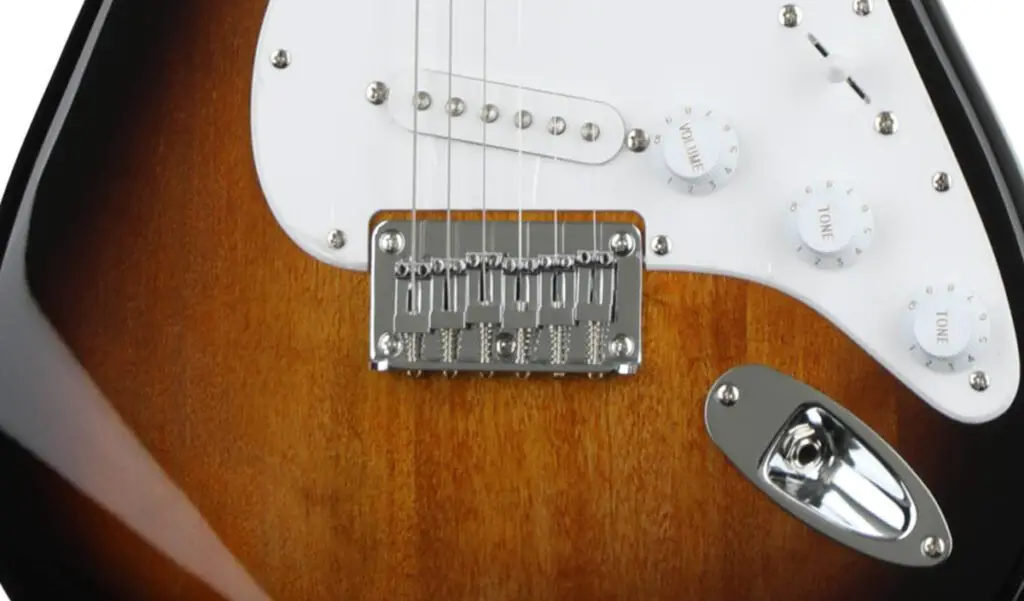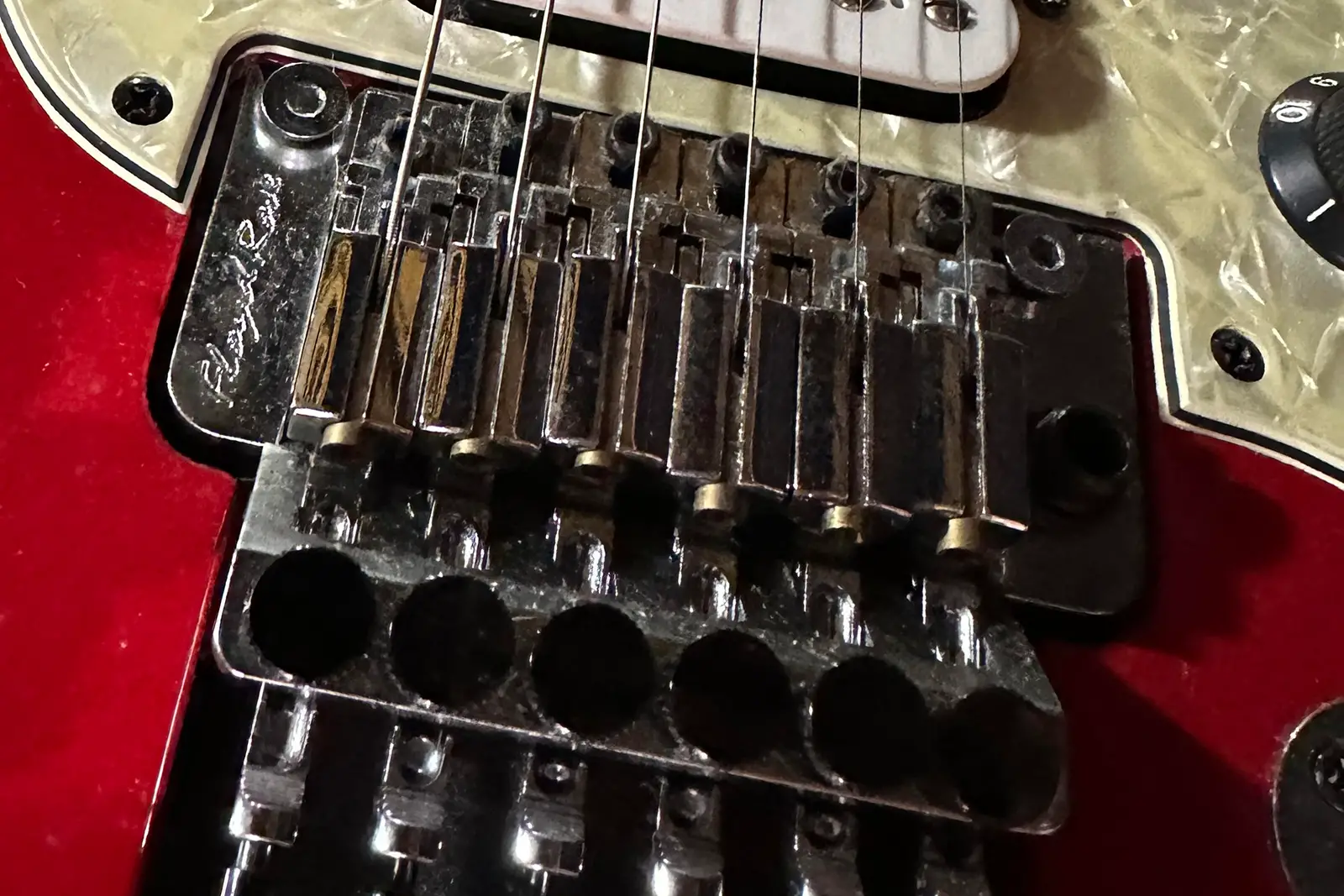In the vast world of guitars, one intriguing and versatile element that contributes to a guitarist’s tone and style is the bridge.
Of the numerous bridge designs available, the floating bridge stands out for its unique ability to enable pitch manipulation, enriching the musician’s sonic palette with the capacity for dramatic vibrato and pitch-bending effects.
What is the point of a floating bridge guitar?
The primary purpose of a floating bridge on a guitar is to allow for pitch bending and vibrato effects via the use of a tremolo bar. It also provides individual string intonation and adjustable action, enhancing playability and tonal variety.
However, floating bridges, while offering a remarkable range of expression, also come with their own set of challenges in terms of maintenance and tuning.
In this article, we’ll look into the world of floating bridges, exploring their purpose, the different types available, their advantages and disadvantages, and tips for their maintenance.

What Is The Point Of A Floating Bridge Guitar?
A floating bridge on a guitar has several advantages, which can enhance the playability and the range of sounds that a guitarist can produce. Here are some of the key points:
- Vibrato and Pitch Bending: The primary purpose of a floating bridge, especially in electric guitars, is to allow for pitch bending and vibrato effects.
By pushing down or pulling up on the whammy bar (also known as a tremolo arm), the guitarist can change the tension of the strings, which in turn changes the pitch.
This can be used for subtle vibrato effects, dramatic dive bombs, or anything in between.
- Individual String Intonation: Because each string sits on a separate saddle on the bridge, it’s possible to adjust the intonation for each string individually.
This means you can fine-tune the guitar so that it stays in tune across the entire fretboard. - Adjustable Action: The height of a floating bridge can be adjusted, which changes the action of the guitar (the distance between the strings and the fretboard).
This can make the guitar more comfortable to play, depending on the player’s preferences. - Tonal Variety: Some players believe that the type of bridge on a guitar can influence its tone. A floating bridge may contribute to a guitar’s ability to sustain notes, or it may color the sound in other ways.
- Dynamic Response: A floating bridge guitar can have a more dynamic response to playing intensity. For example, hitting the strings harder can produce not only a louder sound but also a slight change in pitch, contributing to a lively, responsive playing feel.
A floating bridge can be a bit more challenging to maintain.
For instance, changing strings or tuning can be more complex, as changing the tension on one string affects the position of the bridge and, therefore, the tuning of all the other strings.
However, many players feel that the benefits outweigh these challenges.
Are Floating Guitar Bridges Good?
Whether a floating bridge is “good” or not largely depends on the individual player’s needs and preferences. Below are some pros and cons that can help you determine whether a floating bridge is a good fit for you:
Pros of a Floating Bridge:
- Versatility: As mentioned earlier, floating bridges allow for greater versatility in terms of effects and sound manipulation, such as pitch bending and vibrato.
- Adjustability: Floating bridges allow for individual string intonation and adjustable action, letting players customize the setup to their liking.
- Sound: Some players feel that floating bridges contribute to better sustain and a unique tone.
- Responsive Feel: The dynamic response of a floating bridge can add to the expressiveness and responsiveness of your playing.
Cons of a Floating Bridge:
- Complexity: Floating bridges can be more complex to set up and maintain. Tuning can be more challenging, as changing the tension on one string affects the tuning of all the others.
- Stability: Depending on the specific bridge design and quality, tuning stability can be an issue, especially when using the tremolo bar extensively.
- Changing Strings: Changing strings can be more involved on a guitar with a floating bridge.
- Limited Downward Pressure: Some styles of playing, particularly slide guitar, may be more challenging on a floating bridge due to the reduced downward pressure on the strings.
Floating bridges can be great for players who value their unique benefits and are willing to put in a bit of extra work for maintenance and setup.
Floating bridges may not be the best choice for those who prefer simplicity and stability over the ability to make intricate adjustments and perform pitch-bending effects.
What Are The Disadvantages Of A Floating Bridge?
While floating bridges have many benefits, they do come with some drawbacks. Here are the main disadvantages associated with a floating bridge on a guitar:
- Tuning Stability: One of the most common issues with floating bridges is tuning stability. Because the bridge is designed to move, aggressive use of the tremolo bar can sometimes cause the guitar to go out of tune. This issue varies depending on the quality of the bridge and the overall setup of the guitar.
- Complexity in Maintenance: Guitars with floating bridges can be more complex to maintain. The process of changing strings or adjusting the action and intonation is often more involved compared to fixed bridge guitars. Adjusting one string’s tuning can affect the other strings due to the balance needed in a floating bridge setup.
- Difficult for Beginners: For beginners, a floating bridge might pose an extra challenge. Learning to tune the guitar and change the strings are essential skills, and both can be more difficult on a guitar with a floating bridge.
- Change in Tone: While some players like the tone of a guitar with a floating bridge, others may find that the bridge affects the tone in ways they don’t like. Some players feel that floating bridges do not have as much sustain or resonance as fixed bridges.
- Limited Downward Pressure: Depending on the style of music, a floating bridge might not be the best choice. For instance, if you play a lot of slide guitar, a floating bridge might not work well because it doesn’t allow for a lot of downward pressure on the strings.

Is A Fixed Bridge Better Than A Floating Bridge?
Whether a fixed bridge is better than a floating bridge largely depends on your personal preferences and the style of music you play. Both types of bridges have their advantages and disadvantages.
Here’s a brief comparison:
Fixed Bridge
Advantages
- Stability: Fixed bridges are usually more stable in terms of tuning, especially after heavy playing or bending strings. This can be a significant advantage for beginners or for those who do not want to spend a lot of time tuning their guitar.
- Maintenance: Guitars with fixed bridges are generally easier to maintain. Changing strings is straightforward, and there’s no need to balance the tension of the strings against the bridge springs as you do with a floating bridge.
- Tone: Some players believe that fixed bridges provide better sustain and a more solid tone due to the direct contact with the guitar body.
Disadvantages:
- Limited Pitch Control: Fixed bridges do not allow for the same level of pitch control as floating bridges. You can’t use a tremolo bar for pitch-bending effects.
Floating Bridge
Advantages
- Pitch Control: With a floating bridge, you can use a tremolo bar to create vibrato, pitch bending, and other effects.
- Adjustability: Floating bridges typically allow you to adjust the intonation for each string individually. This can result in a more precise tuning across the entire fretboard.
Disadvantages
- Tuning Stability: Floating bridges can sometimes lead to tuning instability, especially when the tremolo bar is used extensively.
- Maintenance: Floating bridges are more complex to set up and maintain. Changing strings and tuning can be more difficult compared to guitars with fixed bridges.
It really comes down to what you want out of your guitar. If you want easy maintenance and tuning stability, a fixed bridge might be better for you. If you’re interested in effects like pitch bending and don’t mind a bit more complexity, a floating bridge might be the way to go.
Floating Bridge Types On Guitar
Floating bridges have been a mainstay of electric guitar design for many decades, and there are several types of floating bridge systems, each with its own unique features and benefits.
Here are some of the most common:
- Fender Synchronized Tremolo: This is one of the earliest types of floating bridge, introduced by Fender on models like the Stratocaster. It allows for pitch bending in both directions but is not designed for extreme changes in pitch.
- Bigsby Vibrato Tailpiece: The Bigsby is a classic design that’s been used on many hollow body and semi-hollow body guitars. It provides a more subtle vibrato effect and doesn’t allow for as much pitch variation as some other designs.
- Floyd Rose Tremolo: The Floyd Rose is designed for extreme pitch changes and high-performance usage. It features a double-locking design that locks the strings at both the bridge and the nut to provide excellent tuning stability, even with heavy whammy bar usage.
- Ibanez Edge Tremolo Systems: Ibanez offers several types of floating tremolo systems, including the original Edge, the Lo-Pro Edge, and the Edge Pro. These are similar in concept to the Floyd Rose system and are known for their high performance and tuning stability.
- Kahler Tremolo System: The Kahler is another high-performance tremolo system that allows for large pitch variations. Unlike the Floyd Rose, the Kahler system doesn’t require the strings to be locked at the nut.
- Gibson Vibrola: Found on several Gibson models, this floating bridge system provides a smooth vibrato effect. Variations include the Maestro Vibrola with its distinctive long arm and the shorter Lyre Vibrola.
- Wilkinson Tremolo: The Wilkinson Tremolo is a more modern design that aims to offer the functionality of a Floyd Rose but with easier setup and maintenance. It features a unique design where the strings lock at the bridge but not at the nut.
These are just a few examples. There are many variations and proprietary systems out there, each offering its own take on the floating bridge concept.
Conclusion
From the subtle vibrato effects of the Bigsby Vibrato Tailpiece to the extreme pitch changes enabled by the Floyd Rose Tremolo, floating bridges offer a world of expressive possibilities for guitarists.
They can enrich your playing with a unique tonal variety and dynamic response, although they come with their own set of challenges in terms of tuning stability and maintenance.
Whether a floating bridge is right for you depends largely on your playing style, musical preferences, and willingness to navigate the intricacies of setup and maintenance.
If you value pitch-bending effects and individual string intonation and are willing to invest time in mastering the technicalities, a floating bridge can be a fantastic tool in your musical arsenal.
Ultimately, the world of floating bridges is a testament to the innovative spirit of guitar design and the endless pursuit of musicians to expand the boundaries of their sound. In this exploration, we hope you’ve gained a deeper understanding of these unique devices and feel equipped to make an informed decision about incorporating them into your own musical journey.
Happy playing!

